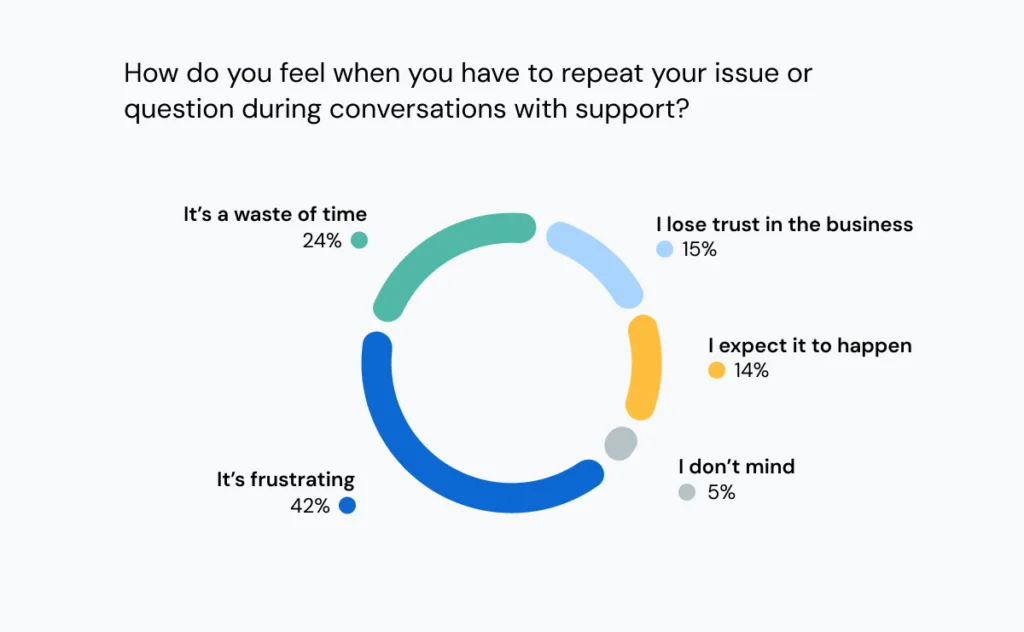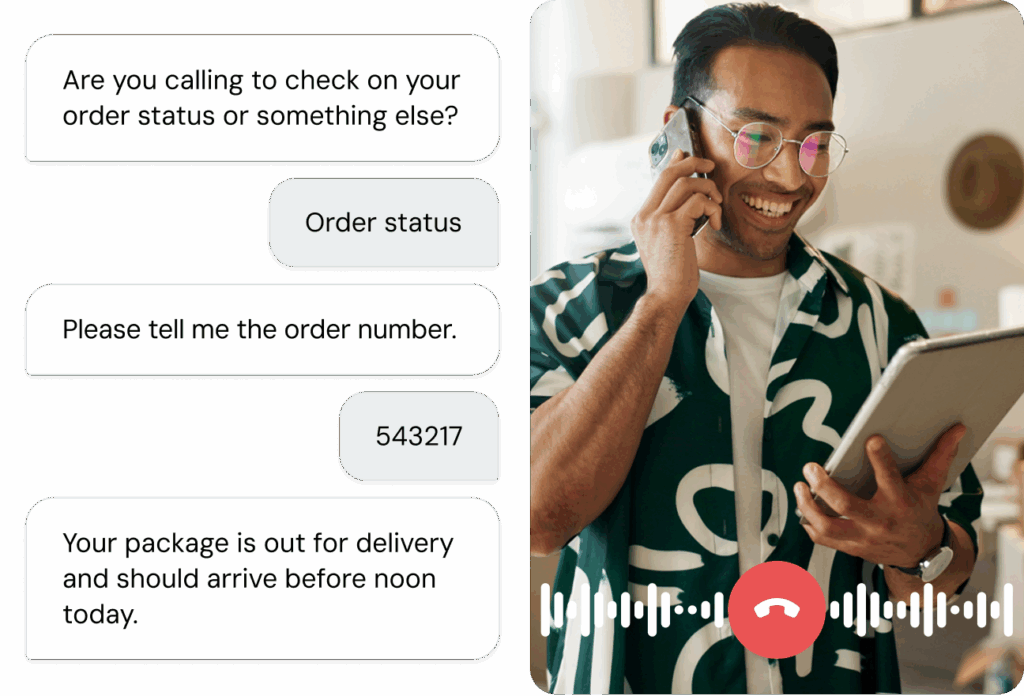Insights, Products
How to improve the IVR system in your call center, without a total rip-and-replace

Insights, Products

Your IVR system isn’t working as hard as it should. Most call centers deal with outdated systems that create customer frustration and waste agent time instead of reducing call volume. The good news: You don’t need a complete overhaul to fix this. Modern Voice APIs can breathe new life into your existing setup.
Interactive Voice Response (IVR) sits in every contact center. You probably assume it’s working fine, but is it actually doing what it’s supposed to?
Sure, it routes calls and plays hold music. But if you’re watching agents handle the same repetitive questions all day, customers hanging up after two minutes in your phone tree, and call containment rates stuck below 30%, then your system is just going through the motions.
Initially, your IVR was supposed to resolve common issues without agent intervention, reduce average handle time, and actually save money. Now, you’ve just accepted a “good enough” baseline because overhauling seems impossible.
However, a Voice API integration, can get you those results – without a complete rip and replace of your current setup.
In this article, we’ll audit where your current system most likely falls short, identify the specific gaps costing you money and customer satisfaction, and show you how modern Voice API solutions can plug those holes without requiring a complete technology overhaul.
Legacy IVR systems often operate in complete isolation from the rest of your tech stack. They can’t pull customer information, can’t create tickets, and definitely can’t tell you why Mrs. Johnson hung up after navigating through four different options on her keypad.
Here’s what might be happening in your contact center:
You’re not alone in this struggle. Sinch research among 1,600 business leaders in the U.S. found that 45% of businesses report that their communication channels are only partially or minimally integrated with tech systems, and 38% cite integration with other systems as a top challenge.
Operations teams sometimes accept this as “normal” because the system technically works. But consider the actual cost: Every call that should have been contained adds three to seven minutes to agent workload. Multiply that across hundreds of daily calls, and your “good enough” IVR could be quietly draining productivity and budget.
That calculation shows that your outdated IVR isn’t just sitting there doing nothing. It’s actively costing you in ways that add up quickly.
Your IT team spends hours each month updating call flows that should take minutes to modify. Authentication processes that could happen instantly instead force customers through lengthy verification steps before reaching an agent.
Then there’s the customer experience fallout. When people can’t access self-service options for simple FAQs or order status checks, or have to repeat their problem three times before reaching a live agent, they start looking at competitors that can help them quickly.
As our own research shows: 80% of consumers have a negative reaction when asked to repeat information during customer support conversations.

Your agents feel it too. Handling the same password resets and balance inquiries that an intelligent system should resolve automatically creates burnout and turnover.
In the end, you pay for a solution that doesn’t deliver what you need, leaves agents exhausted, customers upset – and impacts your ROI.
That’s not what a modern IVR experience should look like. Here’s what you should really get out of an efficient IVR.
An up-to-date IVR should give you full control over call flows, automation features, and valuable data.
Inefficient IVR flows are one of the top reasons for extended call times, agents handling repetitive customer support work, and missing containment targets. When your system forces every caller through the same rigid menu tree, you’re wasting everyone’s time.
A modern IVR system gives you complete control over how calls flow through your system. You can build a custom logic that adapts to different situations and caller types:
This level of control means you can optimize for actual business outcomes and streamline issue resolution, not just process calls.
Your current IVR technology probably gives you basic call volume reports and not much else. An IVR built on a modern Voice API, on the other hand, shows you exactly what happens during each call instead of leaving you to guess why customers hang up.
Here’s what you can track and act on:
This visibility changes how operations managers approach IVR optimization. Instead of guessing why customers drop calls after the third menu option, you can see exactly where the friction occurs. Instead of wondering why containment rates vary throughout the day, you can identify peak performance periods and replicate those conditions.
IVRs become measurable, improvable components of your customer experience stack instead of necessary evils that must be endured before reaching a human agent.
While all of this sounds great, replacing an IVR system in a contact center can feel like a monumental task. Operations teams often hesitate to overhaul their entire contact center stack, coordinate staff training, and manage a lengthy implementation process.
But you don’t need to replace everything. A modern API-based IVR can integrate with your existing infrastructure, giving you the automation and intelligence you need without the overhaul you’re dreading.
A modern IVR solution doesn’t mean starting from scratch with new hardware or throwing out your existing contact center. Instead, you implement a powerful IVR that’s built on a robust infrastructure and flexible APIs – which means it’ll easily connect to your tech stack.
It can also be integrated by your developer team, without needing to hire external telephony experts. To put it plainly: With a programmable voice API, you can build customized and effective Interactive Voice Response workflows.

Think of it as adding a smart front door to your current setup. The API-powered IVR becomes the first point of contact, handling authentication, account lookups, and common requests before deciding whether human intervention is actually needed. When it does need to transfer a call, it passes along context and customer data, so your agents aren’t starting from scratch.
This architecture means you keep your existing agent workflows, reporting systems, and training processes intact while improving operational efficiency. Your agents still use the same interfaces they’re familiar with. The difference is that fewer calls reach them, and when calls do come through, they arrive with complete context.
Before you start evaluating IVR solutions, you need to understand exactly where your current system is failing. These four questions will give you a clear baseline and help you make the case for improvement.
This is your containment rate – the single most important metric for IVR performance. If you don’t know this number, that’s already a red flag. Industry benchmarks vary, but if you’re below 20%, your system is essentially just an expensive call router.
Track how long it takes to make simple changes like updating hours, adding a new menu option, or changing routing rules. If your IT team needs days or weeks to implement basic updates, you’re losing agility and wasting resources.
Look at your CRM, ticketing platform, customer database, and other core systems. If your IVR operates in isolation, customers are repeating information and agents are starting every call from scratch.
Check your net promoter and customer satisfaction scores specifically for phone interactions. Survey your agents about repetitive tasks and frustrations. If both groups are consistently frustrated with phone experiences, your IVR isn’t doing its job.
These answers will show you exactly where improvement is needed and help justify the investment in a modern Voice API solution.
This isn’t about chasing shiny new tools – it’s about getting measurable returns from what should be a core part of your customer experience strategy.
The numbers speak for themselves. When you can resolve even 10% more calls in the IVR, that translates directly to reduced agent workload and lower operational costs. A system that can authenticate customers automatically saves 30 to 60 seconds per call. Multiply that across thousands of monthly interactions and you’re looking at significant time savings.
But the real impact goes beyond cost reduction. Customers who can get answers quickly without waiting for an agent have better experiences and higher satisfaction scores. Agents who handle fewer routine inquiries can focus on complex problems that actually require human expertise.
Small changes can make a big impact. Better routing reduces transfer rates. Smart authentication cuts handling time. Contextual handoffs improve first-call resolution.
Ready to see what modern IVR could do in your contact center without a rip-and-replace project? Explore how Sinch’s Programmable Voice API can integrate a smart IVR solution with your existing infrastructure and start delivering better outcomes today.